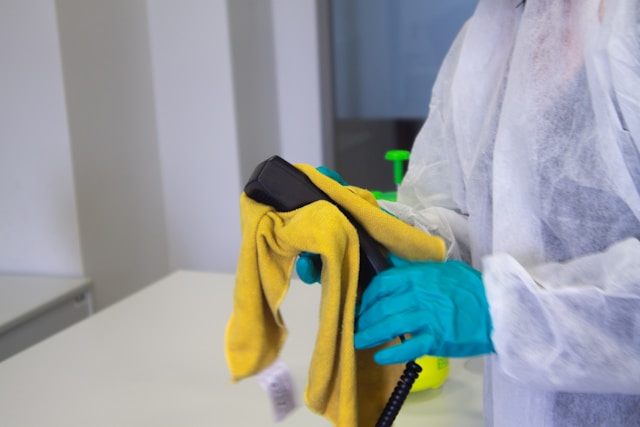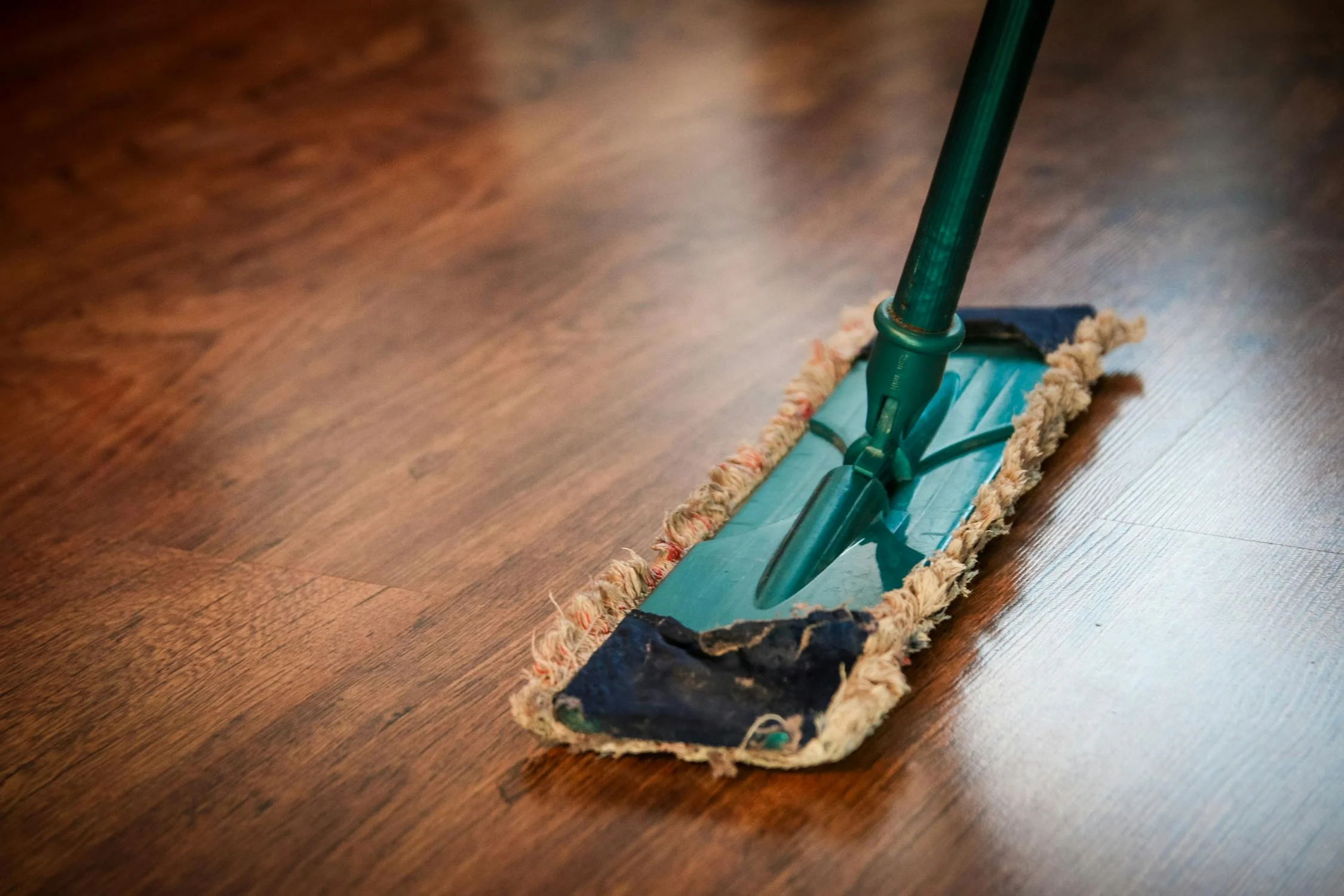You’ll need extra attention to dust control when cleaning after a kitchen remodel since construction debris can overwhelm standard filtration systems and compromise indoor air quality. Your HEPA vacuum systems and air scrubbers must run continuously during cleanup to capture fine particles while protecting adjacent office spaces from cross-contamination. Protect newly installed surfaces with breathable barriers and use eco-friendly cleaning solutions that won’t leave harmful residues or interact negatively with fresh construction materials.

Why IAQ Matters in Commercial Offices
You’ll notice significant impacts on your office environment when indoor air quality suffers, as poor IAQ directly affects employee wellness and output. Common workplace pollutants like volatile organic compounds, mold spores, and carbon dioxide can accumulate quickly in spaces with inadequate ventilation systems, leading to increased sick days and decreased concentration. By taking steps to improve your office’s air quality through proper filtration and ventilation, you’re investing in both your team’s health and their ability to perform at their best.
Indoor air quality directly impacts employee health, comfort, and productivity. Pollutants like VOCs, mold spores, and CO₂ buildup are common in office environments with limited ventilation. Addressing IAQ leads to fewer sick days, improved focus, and a more professional workspace
Poor indoor air quality can hold back your employees from performing their best. When stuffy air, mystery odors, and invisible pollutants lurk in your workspace, productivity takes a nosedive. That’s why implementing HEPA filtration commercial systems and eco-safe office cleaning practices isn’t just about meeting IAQ standards workplace requirements – it’s about keeping your team breathing easy and focused instead of heading home with headaches.
HEPA Filtration: What It Does and Why It Works
HEPA filters give you unmatched air cleaning power by trapping 99.97% of particles as tiny as 0.3 microns. You’ll find these advanced filters catch everything from common dust and pollen to microscopic mold spores and certain viruses through their mechanical filtration process. Unlike ozone or ionic purifiers that can create harmful byproducts, HEPA technology provides consistent, safe air purification for your commercial space.
HEPA filters capture at least 99.97% of airborne particles as small as 0.3 microns. They’re highly effective against dust, pollen, mold, and even some viruses—outperforming ozone or ionic systems without producing harmful byproducts. Their mechanical filtration offers safe, consistent air purification
Air quality experts agree that HEPA filtration represents the gold standard in commercial office air purification, capturing an impressive 99.97% of microscopic particles down to 0.3 microns in size. Unlike those flashy ozone generators that’ll have you coughing up a storm, HEPA filters quietly trap dust, pollen, and pesky microbes without any harmful side effects. They’re like bouncers for your office air – nothing sketchy gets past them!
How to Integrate HEPA Systems into Office Environments
You’ll find that integrating HEPA systems into your office space requires strategic placement of portable air purifiers in high-traffic zones like conference rooms and open workspaces. To maximize effectiveness, you can outfit your existing HVAC system with a dual-stage filtration setup, using pre-filters to catch larger debris before air passes through HEPA filters for fine particle removal. When selecting units, you’ll need to match the Clean Air Delivery Rate (CADR) to your room dimensions and typical occupancy levels to guarantee proper air cleaning capacity.
Businesses can use portable HEPA purifiers in high-traffic areas or retrofit HVAC systems with a two-stage setup: pre-filters for larger particles and HEPA for fine particulates. It’s important to choose units with appropriate Clean Air Delivery Rates (CADR) based on room size and occupancy
Businesses have two main options for implementing HEPA filtration in their offices: portable units for targeted areas or integrated HVAC system upgrades. You’ll want to strategically place HEPA air purifiers in high-traffic zones like conference rooms and break areas. For whole-building protection, commercial HVAC upgrades with dual-stage filtration are your best bet. Just don’t forget to check those clean air delivery rates – size definitely matters here!
Supporting Strategies for IAQ Improvement
You’ll get the most from your HEPA filtration system by implementing complementary strategies like enhanced ventilation and regular HVAC maintenance. Installing real-time monitoring devices lets you track critical IAQ metrics including CO², humidity, and PM2.5 levels, enabling quick responses to air quality issues. Your maintenance team should perform consistent system checks and cleaning to prevent mold growth and dust buildup in components, which can compromise filtration effectiveness.
Enhance HEPA performance with better ventilation, HVAC maintenance, and real-time air monitoring tools. Tracking CO₂, humidity, and PM2.5 levels helps managers respond proactively to air quality concerns. Consistent upkeep prevents mold and dust accumulation in system components
To maximize HEPA filtration’s effectiveness, proper ventilation and monitoring systems must work in tandem. You’ll want to pair those fancy HEPA vacuum systems with strategic HVAC IAQ upgrades – think of it as giving your office a high-tech breathing upgrade! Real-time IAQ monitoring lets you catch air quality issues before they become headaches. Keep those sensors happy, and they’ll keep your workspace’s lungs happy too.
Eco-Safe Cleaning Practices That Complement HEPA Filtration
You’ll find that eco-friendly cleaning products work seamlessly with HEPA filtration by avoiding harmful VOCs that can compromise indoor air quality. Your cleaning team should use microfiber cloths and damp-dusting techniques while running HEPA air purifiers to capture airborne particles during the cleaning process. These sustainable practices not only protect your workspace environment but also enhance the effectiveness of your HEPA filtration system in maintaining clean, healthy air.
Green cleaning products reduce the introduction of VOCs and support IAQ goals. HEPA-compatible cleaning involves microfiber cloths, damp dusting, and simultaneous air purifier use to keep airborne pollutants at bay. This combination ensures a clean, healthy workspace with minimal environmental impact.
Maintaining best indoor air quality requires more than just HEPA filtration – it demands a thorough approach to green cleaning. You’ll want to pair your office air purifier placement with green commercial cleaning practices that pack a one-two punch. Think microfiber cloths that trap dust like tiny magnets and HEPA-level cleaning protocols that don’t release nasty VOCs into your workspace. It’s like giving your office a spa day, minus the cucumber water.
